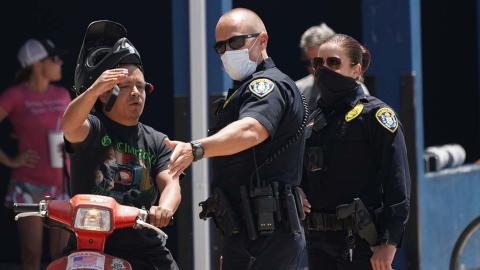<p></p>
<p>The San Diego Police Department today announced that it will ban officers from using the restraint hold that killed Geoge Floyd in Minneapolis last week and has led to days of protests and riots across the country.</p>
<p>Police Chief David Nisleit, along with Mayor Kevin Faulconer, and City Council members Georgette Gomez and Monica Montgomery, announced that SDPD officers would immediately stop using carotid restraints or “sleeper holds” as a use-of-force procedure. The hold, a form of a chokehold, is done by applying pressure to carotid arteries on the side of a person’s neck to render the person unconscious. A regular chock hold puts pressure on the front of the neck and throat, cutting off airflow and suffocating the suspect.</p>
<p>“We are watching the hurt and pain so many people are expressing after the tragic death of George Floyd and are committed to taking new actions to make sure something like this doesn’t happen in San Diego,” Mayor Faulconer said. “That starts today with the Police Chief’s decision to immediately stop this particular restraint that has led to so much concern and frustration by many in our minority communities.”</p>
<p>Floyd died last week after an arresting officer applied too much pressure to the back of Floyd’s neck while he was handcuffed and lying in the street. Eyewitness cell phone videos show the officer, Derek Chauvin, kneeling on Floyd for over eight minutes as other officers watched. Floyd can be heard saying, “I can’t breathe” and bystanders yelling at the officers to help Floyd.</p>
<p>“I started evaluating this policy last week following the terrible events in Minneapolis and believe now is the right time to make this change,” Chief Nisleit said at the press conference. “Effective immediately, I have placed a stop on the use of the carotid restraint among our police department. I have heard from the community, and the department wants to work toward strengthening our community partnerships to keep all San Diegans safe.”</p>
<p>The incident in Minneapolis began when police were called after reports that Floyd had used a counterfeit $20 bill in a local store. The store surveillance camera recorded the incident that shows Floyd being cooperative with officers until he seems to experience some sort of health problems. Officers called for an ambulance and that’s when they put the handcuffed Floyd on the street. When the ambulance arrived, Floyd was unconscious. He was pronounced dead at a nearby hospital.</p>
<p>The arresting officer, Derek Chauvin, along with three other officers that detained Floyd, were fired the day after the incident. Two days later, Chauvin was arrested and charged with third-degree murder and manslaughter. The three other officers have invoked their 5th Amendment right against self-incrimination but have not been charged with any crimes.</p>
<p>Protests erupted in Minneapolis after Floyd’s death and have expanded to other cities around the country, including in San Diego County. Protests in La Mesa, Santee, Chula Vista, National City, and San Diego have included thousands of people. In San Diego, some protests turned violent when demonstrators broke building windows, looted stores, and graffitied property. Police used tear gas and flash-bang grenades to disburse the crowds. Some protesters on Sunday walked on to Southbound lanes of I-5 near downtown and blocked traffic.</p>
<p>National Guard units have been activated in San Diego as a precaution in case local police cannot contain protests. Curfews have been called in National City, Poway, Lakeside, and Spring Valley.</p>
Image
Image

Category